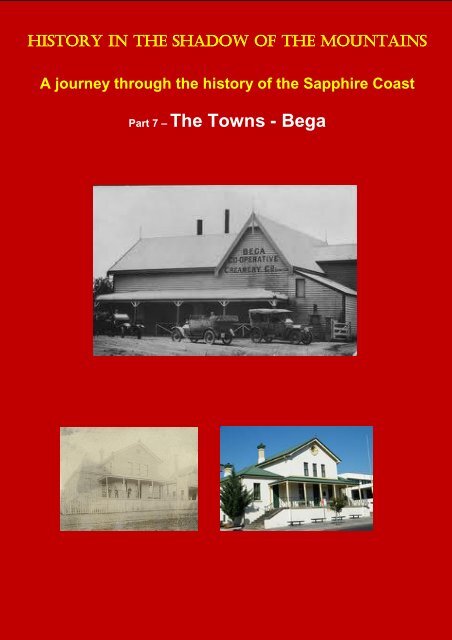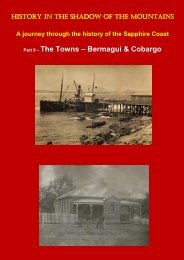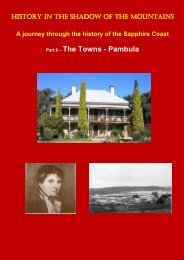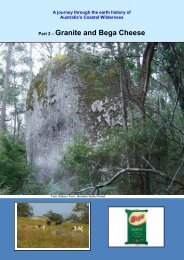A journey through the history of the Sapphire Coast
A journey through the history of the Sapphire Coast
A journey through the history of the Sapphire Coast
Create successful ePaper yourself
Turn your PDF publications into a flip-book with our unique Google optimized e-Paper software.
HISTORY IN THE SHADOW OF THE MOUNTAINS<br />
A <strong>journey</strong> <strong>through</strong> <strong>the</strong> <strong>history</strong> <strong>of</strong> <strong>the</strong> <strong>Sapphire</strong> <strong>Coast</strong><br />
Part 7 – The Towns - Bega
Bega<br />
(Bega map on <strong>the</strong> last page)<br />
Bega at <strong>the</strong> turn <strong>of</strong> <strong>the</strong> 19 th century.<br />
Squatters moved into <strong>the</strong> Bega Valley from <strong>the</strong> inland areas <strong>of</strong> Monaro and<br />
Braidwood and staked out <strong>the</strong>ir grazing ‘runs’ in <strong>the</strong> early 1830s. Part 4 <strong>of</strong> this series<br />
describes <strong>the</strong>se events, including <strong>the</strong> 1834 arrival <strong>of</strong> <strong>the</strong> Imlay bro<strong>the</strong>rs, who<br />
acquired over 65,000 acres <strong>of</strong> runs and began permanent settlement <strong>of</strong> <strong>the</strong> area<br />
including <strong>the</strong> ‘Tarraganda’ run at ‘Biggah’.<br />
Government Surveyor Parkinson laid out a new town at what is now North Bega (on<br />
<strong>the</strong> site <strong>of</strong> <strong>the</strong> present Bega Cheese Factory). The origin <strong>of</strong> <strong>the</strong> name Bega is not<br />
definitive but is probably based on <strong>the</strong> Aboriginal word ‘Biggah’, which is thought to<br />
mean ‘big camping ground’ or ‘beautiful’.<br />
After a disastrous flood In May 1851 <strong>the</strong> town was moved to higher ground on <strong>the</strong><br />
sou<strong>the</strong>rn side <strong>of</strong> <strong>the</strong> river where it still stands today. In <strong>the</strong> first plan, <strong>the</strong> main street<br />
was Auckland Street, hence <strong>the</strong> construction <strong>of</strong> substantial buildings along that<br />
street. When <strong>the</strong> town centre moved Carp Street became <strong>the</strong> main street.<br />
The first town allotments were surveyed in February 1854 and sold at Eden in August<br />
<strong>of</strong> that year. Eden was <strong>the</strong> only port for communication and transport until Merimbula<br />
port was opened in 1855.<br />
In 1858 <strong>the</strong> Victoria Inn was opened in Auckland Street, and in 1859 <strong>the</strong> Family Hotel<br />
opened on <strong>the</strong> corner <strong>of</strong> Bega and Auckland Streets. Both buildings are still in<br />
existence, <strong>the</strong> Family Hotel is now <strong>the</strong> Bega Pioneers’ Museum. You can obtain from<br />
<strong>the</strong> Bega Pioneers’ Museum a pamphlet for a Bega Heritage Walk that contains a<br />
small map indicating several historic buildings and places. The buildings described<br />
below are just a sample <strong>of</strong> those you can see (http://museumb.freeiz.com ).
Bega Pioneers’ Museum<br />
By 1861 <strong>the</strong> population <strong>of</strong> Bega was 625 in 100 households. The Bega district was<br />
regarded as one <strong>of</strong> <strong>the</strong> few successful areas where land selections under <strong>the</strong> 1861<br />
Crown Lands Acts facilitated orderly settlement <strong>of</strong> <strong>the</strong> lands, with an average<br />
consolidated holding up to 500 acres.<br />
Under <strong>the</strong> Crown Lands Acts, anyone with a small deposit was able to take up Crown<br />
land and convert <strong>the</strong> title to freehold. Men and women with energy and<br />
entrepreneurship took up land in <strong>the</strong> Bega Valley and, with hard work, turned it into<br />
pr<strong>of</strong>itable farms. The ports <strong>of</strong> Tathra and Merimbula were relatively close to <strong>the</strong><br />
farms and this meant that produce could be shipped easily and quickly to Sydney,<br />
Melbourne and Tasmania.<br />
The operation <strong>of</strong> <strong>the</strong> Crown Land Acts is considered to be largely responsible for <strong>the</strong><br />
successful development <strong>of</strong> <strong>the</strong> dairy industry in <strong>the</strong> Bega Valley. This success is<br />
recorded in <strong>the</strong> Morris and Rankin Report to Parliament on <strong>the</strong> State <strong>of</strong> Public Land<br />
in New South Wales (1884) that said:<br />
Bega is one <strong>of</strong> <strong>the</strong> most prosperous districts in <strong>the</strong> colony, and its prosperity is mainly<br />
attributable to <strong>the</strong> fact <strong>of</strong> <strong>the</strong> land having been thrown open to <strong>the</strong> people. Rich land,<br />
mild climate, copious and regular rainfall, and last but not least, easy and cheap<br />
communication by water with <strong>the</strong> metropolis, all <strong>the</strong>se stamp it as a locality peculiarly<br />
adapted for homestead settlement, and upon which (<strong>the</strong>re can be no question) <strong>the</strong><br />
legislation <strong>of</strong> 1861 conferred incalculable benefit....’ Morris and Rankin Report to <strong>the</strong><br />
New South Wales Government in 1884.<br />
Dairy farming expanded quickly <strong>through</strong>out <strong>the</strong> 1860s, overtaking cattle farming as<br />
<strong>the</strong> predominant industry. In 1858, Tathra was used as a port for <strong>the</strong> transport <strong>of</strong><br />
products to Sydney, and <strong>the</strong> Illawarra Steam Company was established. In 1860, <strong>the</strong><br />
Tathra Wharf was constructed by <strong>the</strong> company, which allowed for <strong>the</strong> fur<strong>the</strong>r growth<br />
and expansion <strong>of</strong> <strong>the</strong> dairy industry.<br />
In <strong>the</strong> late 1890s <strong>the</strong> Bega Dairy Co-operative Limited was established. Bega is now<br />
well known for its cheese that is manufactured by <strong>the</strong> Bega Co-operative Society,<br />
one <strong>of</strong> <strong>the</strong> larger Australian cheese companies. ‘Bega Cheese’ is exported around<br />
<strong>the</strong> world and distributed across Australia and is available in most supermarkets and<br />
general stores. You can visit <strong>the</strong> Bega Co-operative and its Heritage Centre and<br />
Tourist Information service in North Bega, by turning <strong>of</strong>f <strong>the</strong> main highway at <strong>the</strong><br />
nor<strong>the</strong>rn end <strong>of</strong> <strong>the</strong> bridge.
Bega Co-operative Creamery in <strong>the</strong> 19 th century<br />
Notable examples <strong>of</strong> Bega’s built heritage<br />
An early picture <strong>of</strong> Bega Courthouse Bega Courthouse today<br />
Bega Courthouse<br />
The Bega Courthouse, erected in 1881, has a lengthy association with <strong>the</strong> town’s<br />
social <strong>history</strong> and a period <strong>of</strong> hectic and impressive building activity by <strong>the</strong> Public<br />
Works Department.<br />
Bega Courthouse is listed on <strong>the</strong> Register <strong>of</strong> <strong>the</strong> National Estate. With its double<br />
height central courtroom and smaller flanking <strong>of</strong>fice wings, Bega Courthouse<br />
illustrates <strong>the</strong> general form <strong>of</strong> courthouses in New South Wales during <strong>the</strong> greater<br />
part <strong>of</strong> <strong>the</strong> 19 th century. The scale <strong>of</strong> <strong>the</strong> building, with its prominent gabled façade,<br />
decorative railing and position at an intersection on Bega's main street, make a<br />
significant contribution to <strong>the</strong> streetscape.<br />
Bega Primary School Group<br />
The buildings <strong>of</strong> <strong>the</strong> Bega Primary School Group are Victorian Free Classical in style<br />
and are representative <strong>of</strong> public school buildings <strong>of</strong> <strong>the</strong> 1880s to1890s period. The<br />
group is listed on <strong>the</strong> Register <strong>of</strong> <strong>the</strong> National Estate.
In 1880 Bega residents petitioned for additions to be built at <strong>the</strong> town primary school<br />
to overcome <strong>the</strong> overcrowding. In fact a new building was approved - <strong>the</strong> present<br />
sou<strong>the</strong>rn building facing Auckland Street. The buildings were occupied by January<br />
1892 and finally completed in September that year. A belltower stands above <strong>the</strong><br />
central entrance. The infants’ building, added later, has a gabled wing similar to that<br />
on <strong>the</strong> 1882-83 building and is also built <strong>of</strong> brick. It has relatively little decoration and<br />
is T-shaped in plan. The residence is stuccoed and painted.<br />
Former Commercial Banking Company building<br />
The Commercial Banking Company (CBC) <strong>of</strong> Sydney building was erected in 1865.<br />
It is understood to have been <strong>the</strong> first bank in Bega, <strong>the</strong> first two-storey building, and<br />
<strong>the</strong> third building <strong>of</strong> substance in <strong>the</strong> town. It is a simple mid-Victorian Colonial style<br />
commercial building constructed <strong>of</strong> English bond brickwork on coursed rubble<br />
bluestone foundation. The building occupies a commanding position at <strong>the</strong> edge <strong>of</strong> a<br />
bluff on Auckland Street that was originally <strong>the</strong> main town street. The building is<br />
listed on <strong>the</strong> NSW State Heritage Register.<br />
Former jeweller’s shopfront<br />
Former CBC building<br />
The former jeweller’s shopfront at 165 Carp Street, dating from about 1899, is an<br />
elaborate and intact example <strong>of</strong> <strong>the</strong> late Victorian shop fitter's art. As such, it is listed<br />
on <strong>the</strong> Register <strong>of</strong> <strong>the</strong> National Estate.<br />
Originally single storey, it was rebuilt as a two-storey building in 1904. The shop has<br />
two curved shop windows with panelled timber stallboards <strong>of</strong> grained oak, a central<br />
door (originally surmounted by a fanlight which has now been partly replaced by a<br />
clock) and a chequered marble floor entrance. Decoration to <strong>the</strong> windows includes
gold painting; <strong>the</strong> shop name is painted in gold on <strong>the</strong> door and at least one window.<br />
There is also a curtain type <strong>of</strong> decoration to <strong>the</strong> upper parts <strong>of</strong> <strong>the</strong> windows. You can<br />
still see where iron grille fences for security were drawn across <strong>the</strong> entrance each<br />
night.<br />
Jewellers’ shopfront in Carp Street











